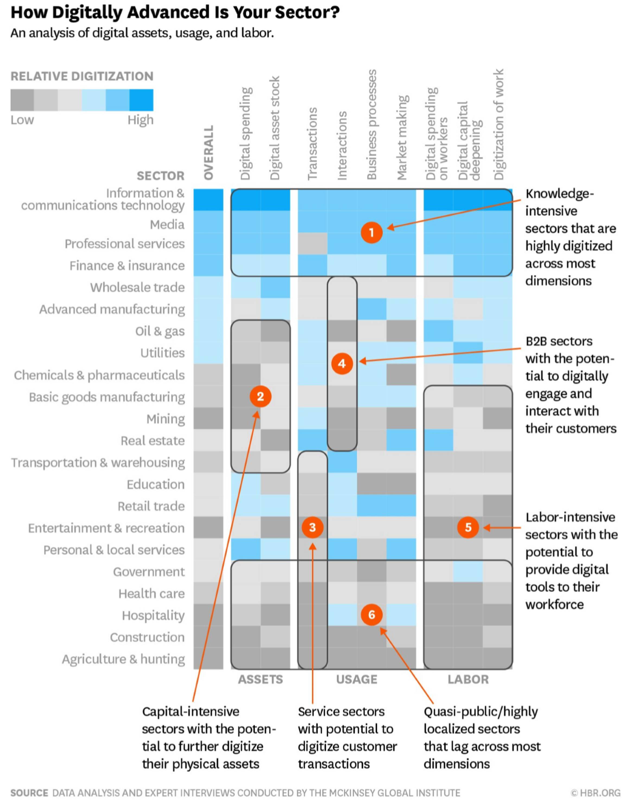Everything is connected today: whether this concerns appliances, machines, cars, buildings, cities or our own body. Digitisation, mobilisation, augmentation, AI and automation are the new normal. Remarkably enough, the large(r) companies are often the failures on the innovation landscape.
Although everyone agrees that a digital transformation is needed, Belgian companies are less digital than they think. Many of them simply don’t know where to start so they put it all off. It is becoming more and more difficult to follow technological evolutions, not to mention not knowing exactly what they mean for your organisation. Nevertheless you are asware that you have to do something about it. The big challenge here? Following the evolutions and considering the future is usually done by individuals at the organisation, and not in teams. You ‘have it’ or you ‘don’t have it’. Some embrace change, others do not. But in the meantime, the competition evolves, or a newcomer suddenly arrives from an unexpected corner of the market.
The new ‘digital competition’ will not go away and your company must take prompt action. More than ever companies must be open to change, to new possibilities and ideas, before the competition seizes the opportunity. Change before the competition does so!
How digital is your industry?
Each industry is gradually feeling the impact of digital transformation, even the sector in which you are operating. But there are big differences in (digital) maturity per industry. A good understanding of this is a first step to getting ahead of your competition.
Recent research by the *McKinsey Global Institute (MGI) revealed the hierarchy in digitisation in the different sectors, and it appears that there is a large and growing gap between sectors and between companies in the sectors. Obviously, the impact of technology varies strongly by sector, and not all industries have the same opportunities or face the same threats. The graph shows a clear picture of the stage your industry is at:
Three digital cornerstones
McKinsey makes a distinction between three aspects of digital evolution:
- Digital assets (see Assets column above): this index measures how much your organisation invests in hardware, software, data and IT services, and the extent to which assets are digitalised (e.g. by making buildings intelligent, automatically monitoring equipment, digitally following up the vehicle fleet, etc.)
- Digital usage (see Usage column above): this index measures to what extent your organisation digitally communicates and interacts with customers and suppliers (e.g. with digital invoices, digital payment, digital marketing, etc.); this aspect usually involves the thorough automation and modernisation of the back-office
- Digital workers (see Labour column above): according to McKinsey this index distinguishes the leaders from the followers, being the extent to which employees have digital tools to increase their productivity; employees of leaders are 13 times more digitally engaged than the rest of the economy.
The necessity
The graph shows us that some industries still have a lot of catching up to do if they too want to evolve. It is therefore important for your organisation to first define why. What is your organisation’s greatest need to change (transformation)? What do you want to achieve with digital transformation? Do you want to supply innovative (digital) services? Optimise internal (business) processes and make them less expensive by means of ICT? Strive for more innovation? Or maybe a combination of these. Each objective requires its own strategy and technology. It is also wise to look at what continued as it is. Transforming does not mean that your organisation must give up its own individuality. So: start with the distinguishing factor at your organisation and further develop from there.
Vision, courage and creativity are crucial
A convincing vision, courage, creativity and perseverance are indispensable to the (digital) transformation of a company. And a management team that firmly resolves to mobilise people, means, assets and stakeholders, and deploy them when much is at stake.
A common pitfall is a ‘too’ technological approach to digital trends and developments. Budgets are spent on specific technologies and tools, but in the meantime how these elements contribute to the strategy and objectives of an organisation is not looked at properly. Without an overarching digital strategy it is nigh on impossible to transform successfully. This is why it is important for an organisation to first take a step back and try to look where your opportunities and requirements lie independent of the technology: what would make things better for your customers, what would improve the situation for your employees, what would the shareholders benefit from? Then you look to see which steps you must take as a company to respond accordingly. Choosing a technology is only a part of all this. The implementations, process changes and enthusing the people who have to work with it are at least as important. A technology must be complementary to the core values, vision and strategy of a company, not vice versa.
People make the difference
Digital transformation obviously comes with its challenges. In a fast-changing world in which everything (processes, appliances, products, services, …) is being digitalised, we believe it is particularly the employees who can make the difference. They are the only ones who can respond to changing circumstances by adapting their way of working to serve the customer better. It is people who lead the transformation, or often also obstruct it with resistance. And there is the big challenge Spikes believes (and also a big mission) for the CEO, CIO, CHR, etc. of today: preparing the organisation to implement the changes to both skills and culture, and getting people on side. Providing the right platforms and digital resources with which employees at the organisation can evolve, or even initiate the evolution themselves.

The roadmap for your transformation
Although the road to digital transformation is long, we see increasing numbers of companies taking their first step! The pioneers at the companies want to change, and introduce projects to initiate digital transformation. The new way of working, flexible work styles, cloud computing, intelligent systems and the ease of use that business users expect at companies (and that they know from Google and Facebook), will gradually replace the traditional model of end-user computing.
Your customers also expect more transparency, speed and interactivity in their contact with you as a supplier (here also from their private experience of suppliers). And this (r)evolution can no longer be stopped. As mentioned earlier; companies can barely lag behind in this development if they want to stay ahead of the competition.
Spikes has introduced a roadmap or approach consisting of four cornerstones to support organisations here:
1) ‘Business Everywhere’, With this vision and approach we want to help organisations to evolve their applications and environments in their current data centre to become secure hybrid platforms (partly cloud, partly their own data centre) to ensure that employees have secure access to business information with any device, everywhere and always. They can then work together in optimal circumstances with colleagues, customers and suppliers without a risk of the loss or theft of information.
2) Every organisation almost completely relies on team work. This is why in the second step you must make sure that all employees optimally use the possibilities of the platforms to be more productive and more efficient in their collaboration with others. That is indeed the basis for yourself being able to implement changes and quickly respond to the demands of the customer. We call this ‘People First’. It is not only technology that plays its part here, the collaboration culture at the organisation is also a factor.
3) Another important step in your digital transformation is digitalisation of your assets and examining how you can maximally exploit the advantages of this for your customers. What does the Internet of Things (IoT) mean to your organisation? What data can you automatically capture throughout your organisation, to then use them to strengthen your competitive position? That is the ‘Connected Enterprise’ cornerstone.
4) A large quantity of data originates when an organisation works with the new collaboration tools, when your assets are digitalised: who communicates with who (and who NOT), who communicates with customers, are all members of a team sufficiently involved (a characteristic of good teamworking), what is the behaviour of your machines, etc. Making this information available for end users allows them to themselves adapt their behaviour based on trends and suggestions. We call this cornerstone ‘The Sensitive Organisation’.
You can find inspiration here: the Digital Transformation Management Workshop
If you are looking for inspiration and a partner who can help you to clarify which technological evolutions can have your organisation evolve, you can use the Digital Transformation Management Workshops that Spikes offers to inspire your management team and assist it in defining a roadmap for your digital transformation.
Would you like more info about this topic, our services or technologies? Do not hesitate to contact us!




